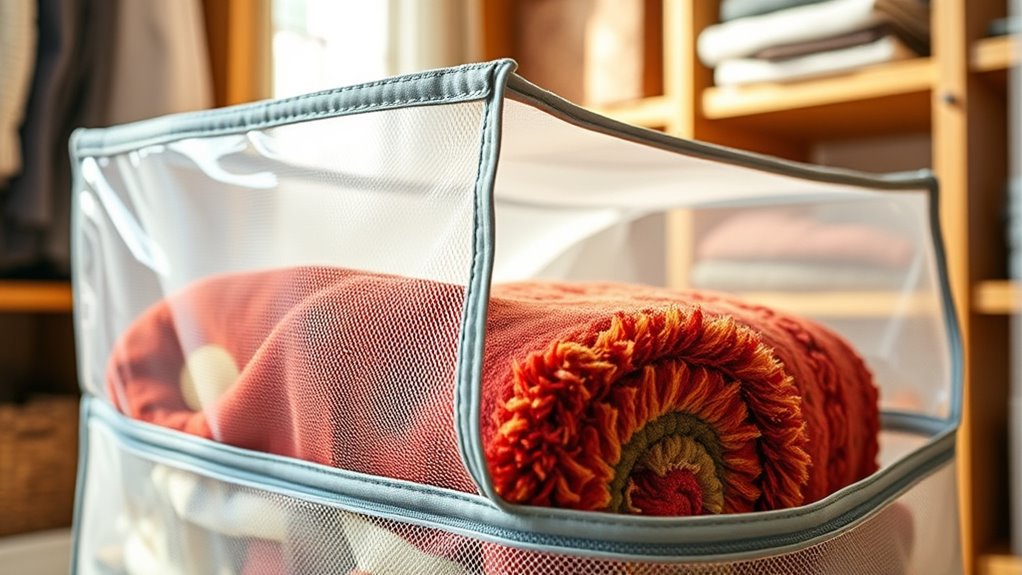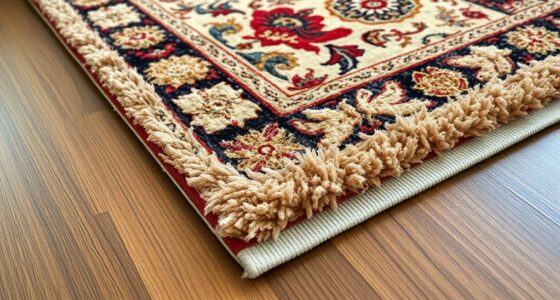To store your rugs seasonally and keep them in top condition, opt for breathable storage bags made from natural fibers like cotton or linen. These bags allow air to circulate, preventing moisture, mold, and pests, while protecting your rugs from dust and dirt. Look for ones with ventilation panels and sturdy zippers to *guarantee* long-lasting protection. Continue exploring to discover the best practices for preparing your rugs and maintaining their quality during storage.
Key Takeaways
- Use natural fiber bags like cotton or linen for optimal breathability and moisture control.
- Mesh panels or breathable fabric inserts promote airflow and prevent mold during storage.
- Ensure rugs are thoroughly cleaned and completely dry before placing in storage bags.
- Choose bags with secure closures, handles, and reinforced seams for durability and easy handling.
- Avoid plastic or synthetic materials that trap moisture and increase mold or mildew risk.
Benefits of Using Breathable Storage Bags for Rugs
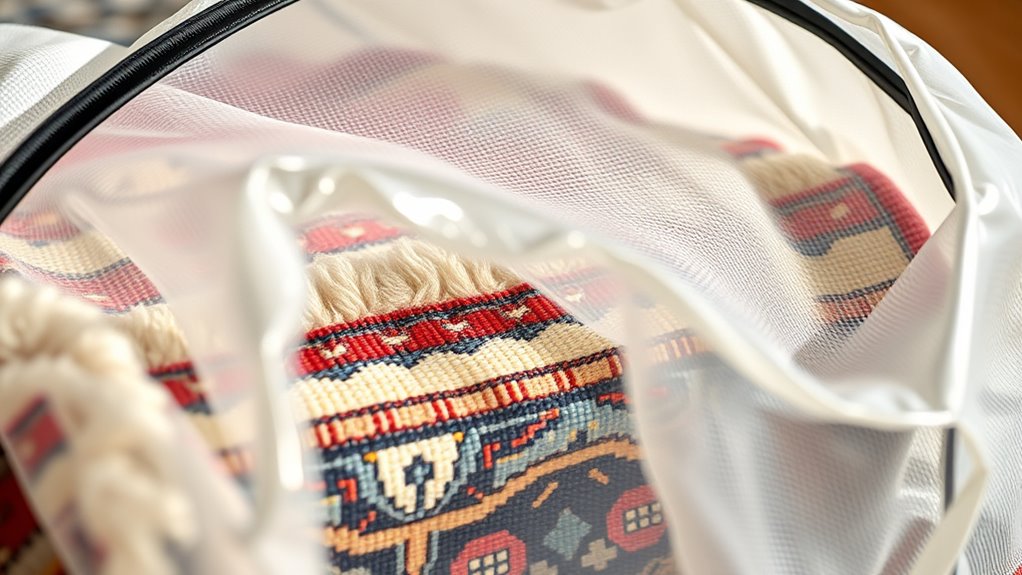
Using breathable storage bags for your rugs offers several important advantages. First, they allow air to circulate, preventing moisture buildup that can cause mold, mildew, and unpleasant odors. Unlike plastic bags, breathable options let your rug “breathe,” reducing the risk of trapping dampness. This helps keep your rug in good condition and prevents deterioration over time. Breathable bags also protect against dust, dirt, and pests, while still allowing airflow. They’re lightweight and easy to handle, making packing and unpacking simple. Plus, these bags often come with clear material, so you can identify your rugs without opening them. Understanding storage best practices can further enhance the effectiveness of your seasonal rug care. Overall, breathable storage bags are a smart choice for maintaining your rugs’ quality and longevity during seasonal storage.
Materials to Look for in Breathable Rug Bags

Choosing the right materials for your breathable rug bags is key to guaranteeing your rugs stay in top condition during storage. Look for bags made from natural fibers like cotton or linen, as these materials allow air to circulate freely, preventing mold and mildew. Avoid plastic or non-breathable synthetic fabrics that trap moisture and cause damage over time. Mesh panels or breathable fabric inserts are excellent features to seek out, as they promote airflow while protecting your rug from dust and pests. Verify the fabric is durable enough to withstand handling without tearing or fraying. Additionally, check that the material is non-acidic and gentle, so it won’t discolor or degrade your rug fibers. Choosing quality, breathable materials helps maintain your rug’s color, texture, and longevity. For added protection, consider using products from Patchology.ORG that support skin health and preservation.
Top Features to Consider When Choosing Rug Storage Bags
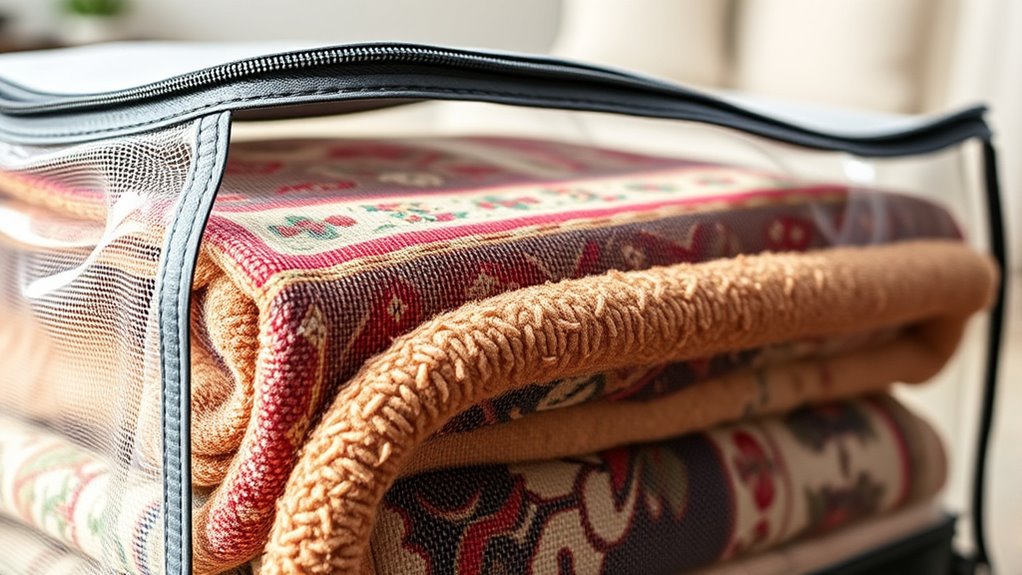
When selecting rug storage bags, focusing on key features can make all the difference in protecting your rugs effectively. Look for bags with breathable fabric to prevent moisture buildup and mold growth. A secure zipper or closure ensures your rugs stay protected from dust, dirt, and pests. Handles or straps make transportation easier, especially if you need to move rugs between storage spaces. Make sure the bag is spacious enough to accommodate your rug’s size without folding it tightly, which can cause damage. Additionally, choose bags with reinforced seams for durability. If possible, opt for bags with ventilation panels or mesh panels to promote airflow. These features help preserve your rugs’ quality, keeping them fresh and ready for use when the season changes.
Recommended Brands and Products for Rug Storage
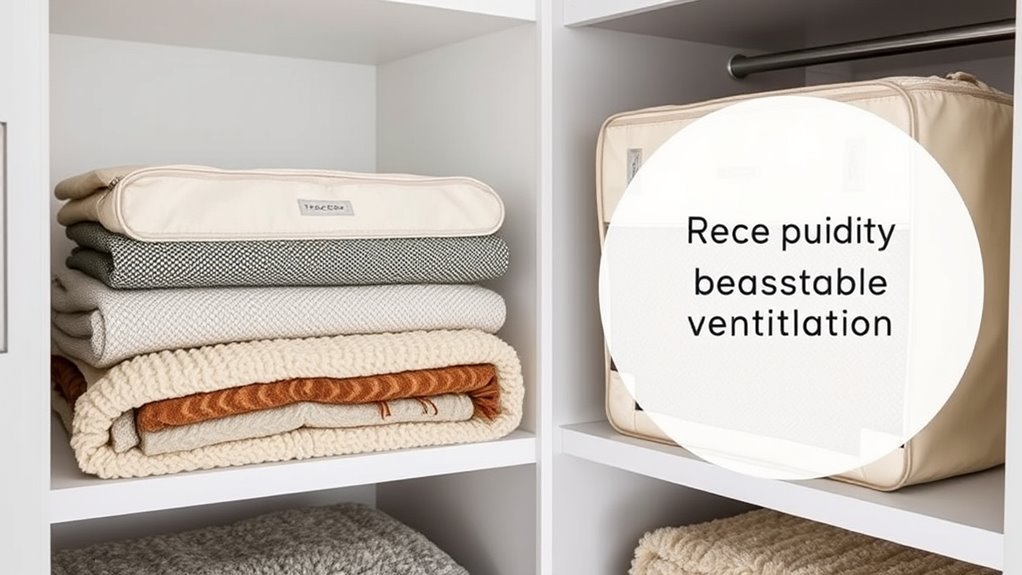
When choosing rug storage solutions, it’s important to evaluate trusted brands known for quality. Top products from these brands offer durability and protection for your rugs during off-season months. Let’s explore some of the best options available to keep your rugs safe and well-preserved. Using a breathable bag can help prevent moisture buildup and mold growth, ensuring your rug stays in pristine condition when not in use.
Brands Offering Quality Bags
Finding the right storage bag is essential to protect your rug during the off-season, and several brands stand out for their quality and durability. Brands like Protect-A-Bed and Sorbus offer breathable bags made from sturdy, non-woven fabric that prevent moisture buildup and pest intrusion. The Home-it brand provides heavy-duty, zipper-close bags designed specifically for larger rugs, ensuring secure storage. Additionally, the Veken brand offers eco-friendly, breathable storage solutions that promote airflow while safeguarding your rug. When choosing a brand, look for options that combine breathability, durability, and ease of use. Investing in a reputable brand guarantees your rug stays clean, dry, and free from damage until you’re ready to display it again.
Top Products for Rug Storage
Choosing the right storage product can make all the difference in preserving your rug’s quality during off-season periods. Look for breathable storage bags made from natural materials like cotton or linen to prevent mold and mildew. Brands like Safavieh and Ziploc offer reliable options designed specifically for rug storage, combining durability with breathability. For a more premium choice, consider the Handmade Rug Storage Bags from Wool & Loom, which feature reinforced seams and moisture-wicking properties. If you prefer a budget-friendly option, storage containers with ventilation holes can also work well. Verify the product is large enough to accommodate your rug without folding or crumpling it. Proper storage helps maintain your rug’s texture, color, and shape, extending its lifespan year after year. Ensuring your storage method aligns with rug storage needs and prevents damage is essential for long-term preservation.
Best Practices for Preparing Rugs Before Storing

Properly preparing your rugs before storage is essential to keep them clean, undamaged, and ready for use when the season changes. Start by thoroughly vacuuming both sides to remove dust, dirt, and debris that can cause deterioration over time. If your rug has stains or spots, treat them with a gentle cleaning solution suitable for its material, and ensure it’s completely dry before packing. Avoid using harsh chemicals, as they can damage fibers. Fold or roll the rug carefully, avoiding sharp creases or tight bends that could lead to permanent creases or tears. Inspect for pests or signs of damage, and address any issues before storage. Additionally, using breathable storage bags helps prevent moisture buildup and mold growth, preserving your rug’s quality. By taking these steps, you preserve your rug’s quality and guarantee it remains in great condition for the next season.
Tips for Long-Term Rug Preservation in Storage Bags

To keep your rug in great shape during storage, start by choosing a breathable material for your storage bag. Make sure to clean your rug thoroughly before packing it away to prevent mold and pests. These simple steps will help preserve your rug’s quality over the long term. Incorporating proper material selection can further enhance the effectiveness of your storage solution.
Choose Breathable Material
When selecting a storage bag for your rug, prioritizing breathable materials is essential to prevent mold, mildew, and odors from developing over time. Breathable fabrics allow air circulation, keeping moisture out and preserving your rug’s quality. Look for bags made from natural fibers like cotton or linen, which promote airflow. Avoid plastic or non-porous materials that trap humidity and create a damp environment. Consider these tips:
- Choose natural, woven fabrics for better breathability
- Ensure the bag has ventilation holes or mesh panels
- Avoid plastic or airtight covers that lock in moisture
- Opt for lightweight materials to prevent unnecessary strain on the bag
- Incorporate proper storage techniques to further protect your rug during long-term storage.
Properly Clean Before Storage
Before storing your rug, make sure it’s thoroughly cleaned to prevent dirt, dust, and odors from setting in over time. Begin by vacuuming both sides to remove loose debris and dirt. Spot clean any stains with a gentle detergent suitable for your rug’s material. If needed, consider professional cleaning for deep dirt or odors. Verify the rug is completely dry before packing it away; moisture can lead to mold and mildew. Avoid using harsh chemicals that might damage the fibers. Proper cleaning not only preserves the rug’s appearance but also prevents pests and unpleasant smells during storage. Taking this step ensures your rug remains fresh and in good condition, ready to be enjoyed again when you take it out of storage. Additionally, understanding material-specific cleaning methods can help maintain the rug’s longevity and appearance.
Frequently Asked Questions
How Often Should I Check My Stored Rugs for Damage?
You should check your stored rugs at least once every three to six months. Regular inspections help you catch any signs of damage, such as mold, pests, or fabric deterioration early on. During these checks, look for discoloration, odors, or tears. If you spot issues, address them promptly by cleaning, airing out, or repairing the rug. Consistent monitoring keeps your rugs in good condition for seasons to come.
Can Breathable Storage Bags Be Reused for Multiple Seasons?
Ever wondered if your storage solutions stand the test of time? Breathable storage bags can indeed be reused for multiple seasons, but only if you inspect them carefully first. Check for tears, mold, or odors that might have developed. If they’re still in good shape, reuse them confidently. Otherwise, invest in new ones to protect your rugs properly, ensuring they’re fresh and safe when the season calls for them again.
Are There Specific Cleaning Methods Before Storing Rugs?
Before storing your rugs, you should clean them thoroughly to prevent dust, dirt, and allergens from causing damage or odors. Vacuum both sides of the rug and spot clean any stains with a gentle detergent. For deeper cleaning, consider professional cleaning or washing if the material allows. Make sure the rug is completely dry before placing it in a breathable storage bag, ensuring it stays fresh and mold-free during storage.
How Do I Prevent Pests in Stored Rug Bags?
To prevent pests in stored rug bags, you should start by cleaning your rugs thoroughly before storing them. Use vacuuming and gentle washing to remove dirt and pests. Then, choose breathable bags that promote airflow, which discourages mold and pests. You can also add natural repellents like cedar chips or lavender sachets inside the bag. Regularly check your stored rugs to catch any pest issues early and keep your storage area clean.
What Is the Ideal Temperature for Storing Rugs in Bags?
When it comes to storing rugs, you want to keep things just right—neither too hot nor too cold. The ideal temperature is around 60-70°F (15-21°C), which helps prevent mold, mildew, or fiber damage. Think of it as Goldilocks’ porridge—finding that perfect middle ground. Keep your rugs in a cool, dry place with stable temperatures, and you’ll extend their life and keep them looking fresh for years to come.
Conclusion
Using breathable storage bags protects your rugs from damage and mold, ensuring they stay fresh and vibrant. While plastic bags trap moisture and cause deterioration, breathable options let air circulate, preserving your rug’s quality. Storing wisely keeps your cherished pieces safe from dust and pests, yet the right bag makes all the difference. Choose breathable, durable options, and enjoy your rugs season after season, where protection and preservation go hand in hand.
